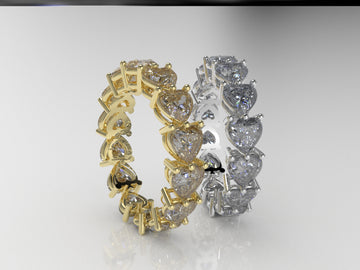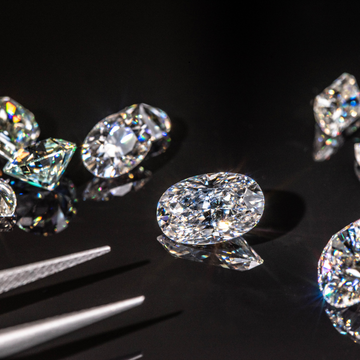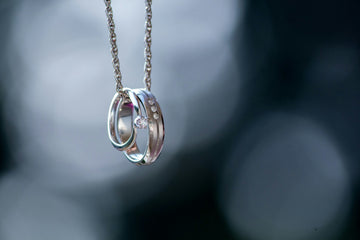When it comes to choosing the perfect metal for fine jewellery, particularly for engagement rings and wedding bands, platinum and white gold are often at the forefront. Both metals exude a luxurious white sheen and are favoured for their elegance and durability. However, they have distinct differences that can influence your decision. Here, we explore these differences and the advantages each metal offers.
Composition and Colour
Platinum is a naturally occurring white metal known for its purity. Jewellery crafted from platinum typically contains 95% platinum, with the remaining 5% composed of other metals like ruthenium or iridium. Its natural white hue remains consistent over time, requiring minimal maintenance to retain its lustre.
White Gold, on the other hand, is an alloy composed of gold and other white metals such as palladium or nickel. To achieve its signature white colour, white gold is usually coated with rhodium, a hard, shiny metal that enhances its appearance. However, this rhodium plating can wear off over time, revealing the yellowish tint of the underlying gold, necessitating periodic re-plating to maintain its appearance.
Durability and Wear
Platinum is highly durable and resistant to wear and tear. Its density and strength make it less prone to scratches and deformation, ensuring that jewellery remains pristine over years of regular use. Platinum’s durability also means it holds gemstones more securely, making it an excellent choice for engagement rings and other pieces featuring precious stones.
White Gold is also durable but not as hard as platinum. Over time, white gold jewellery may develop scratches and require more frequent maintenance compared to platinum. However, the hardness of white gold can be adjusted by varying the composition of its alloy, making it a versatile option for different types of jewellery.
Weight and Comfort
Platinum is significantly denser and heavier than white gold. While some wearers appreciate the substantial feel of platinum jewellery, others may find it less comfortable for everyday wear due to its weight.
White Gold, being lighter, may be more comfortable for those unaccustomed to wearing heavier pieces. This can be particularly advantageous for earrings or larger statement pieces where weight can affect comfort and wearability.
Cost
Platinum is generally more expensive than white gold. This is due to its rarity, higher purity, and the intricate craftsmanship required to work with this dense metal. The higher cost is often justified by its durability and the minimal maintenance it requires.
White Gold offers a more budget-friendly option while still providing a luxurious appearance. The cost of white gold can vary depending on the karat (purity) of the gold used in the alloy. Although it may require periodic re-plating, many find the initial savings significant enough to choose white gold over platinum.
Hypoallergenic Properties
Platinum is hypoallergenic, making it an ideal choice for individuals with sensitive skin or allergies to certain metals. Its purity means it is less likely to cause skin irritations.
White Gold can sometimes cause allergic reactions, particularly if it contains nickel, a common allergen. For those with sensitivities, it’s advisable to choose white gold alloys that use palladium instead of nickel or ensure that the rhodium plating is maintained.
Conclusion: Weighing the Advantages
When deciding between platinum and white gold, it’s essential to consider personal preferences, lifestyle, and budget.
-
Platinum is perfect for those seeking a durable, hypoallergenic, and low-maintenance metal that will maintain its white sheen indefinitely. Its higher cost is often offset by its longevity and the security it provides for set gemstones.
-
White Gold is an attractive alternative for those who prefer a lighter, more affordable option. While it may require more upkeep to maintain its appearance, white gold offers versatility in terms of alloy composition and design possibilities.
Ultimately, both metals provide a beautiful and timeless setting for fine jewellery. Your choice should reflect your aesthetic preferences, practical needs, and financial considerations, ensuring that your selected piece remains a cherished accessory for years to come.




